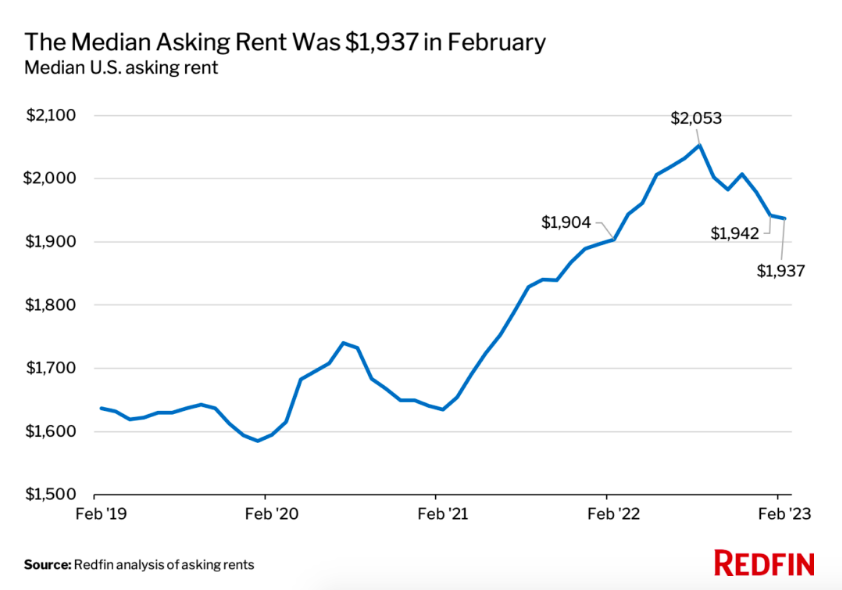As the market remains in financial limbo amid rising rates and nationwide inflation, the median U.S. asking rent rose 1.7% year-over-year to $1,937 in February—the smallest increase in nearly two years and the lowest level in a year, according to a new report from Redfin.
February was the ninth straight month in which rent growth slowed on a year-over-year basis. Rents fell 0.3% from a month earlier. Still, the median asking rent remained 21.4% higher than it was in February 2020, the month before the coronavirus was declared a pandemic.
Rent growth has cooled as persistently high housing costs, inflation, recession fears and a slowdown in household formation have made people less likely to move, putting a damper on demand for new leases. A jump in supply due to a boom in apartment construction has also contributed to the slowdown in rent growth. The number of apartments under construction is up 24.9% year-over-year to 943,000, the highest level since 1974, according to a recent report from the National Association of Home Builders.

“Landlords are slowing their roll on rent increases because they’re grappling with a rise in vacancies as an influx of new apartments hits the market and demand slows from its peak,” said Redfin Deputy Chief Economist Taylor Marr. “Rents are likely close to hitting a floor, though. That’s because stubbornly high inflation is boosting expenses for landlords, so instead of dropping rents they may seek to lure renters with other concessions, like free parking or a discounted security deposit.”
Rents Declined in 11 Major U.S. Metro Areas
- Austin, TX (-6.5%)
- New Orleans (-6.4%)
- Phoenix (-4%)
- Minneapolis (-3.5%)
- Dallas (-2.6%)
- Baltimore (-2.2%)
- Houston (-1.9%)
- Birmingham, AL (-0.5%)
- Chicago (-0.5%)
- Denver (-0.3%)
- Virginia Beach, VA (-0.2%)
Raleigh Saw the Largest Rent Increase
- Charlotte, NC (14.3%)
- Columbus, OH (12.6%)
- Milwaukee (9.5%)
- Nashville, TN (9.0%)
- Indianapolis (8.5%)
- Kansas City, MO (8.3%)
- Hartford, CT (6%)
- Buffalo, NY; Providence RI (5.9%)
- Cincinnati; Louisville, KY; Memphis, TN (5.5%)
- Riverside, CA; San Diego (5.3%)

“While rent growth has slowed, it hasn’t slowed quite as much as expected—in part because the labor market has held up better than anticipated, which has helped prop up demand," said Marr. "This is likely a reason overall inflation remains stubbornly high, as rent growth is a major contributor to inflation.”
To view the full report, including charts, full metro-level breakouts and methodology, click here.

 DSNews The homepage of the servicing industry
DSNews The homepage of the servicing industry









